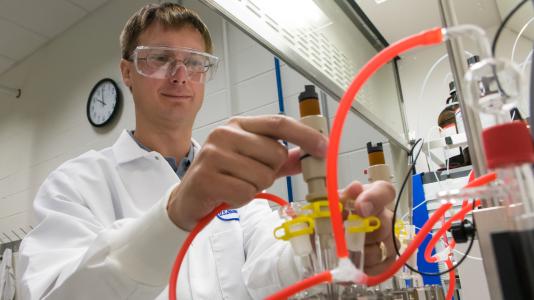
During the last two and a half years, Argonne Technology Development & Commercialization, or Argonne TDC — the business outreach arm of Argonne National Laboratory — underwent an extensive makeover that has put it in the best possible position to help the U.S. Department of Energy achieve its mission to ensure the nation’s security and economic prosperity by addressing its energy, environmental, and nuclear-related challenges.
“The way a national lab accomplishes that is through the research and development of advanced technologies,” said Greg Morin, interim director of Argonne TDC and director of strategy and innovation at Argonne. “But that R&D means very little if the invention simply sits on a shelf gathering dust, doing nothing to improve how Americans — and the world — use energy, or to help U.S. industry develop and commercialize new and advanced technologies.”
Much like a sports team that’s rebuilt its roster of players, Argonne TDC has invigorated its staff with the addition of several talented business development and contracted-research administration professionals, who have had successful private and public sector and startup experience.
Argonne, like its other sister laboratories, doesn’t compete with private industry. Rather, it supports the aims of industry, as long as it harmonizes with the Department of Energy mission. The lab has a long history of licensing its patented technologies, working with private sector concerns to develop marketable technologies that allow U.S.-based business to compete in the global marketplace with unique, state-of-the art technologies.
As the lab moves forward, its aim is to significantly boost the number of projects with private companies.
In recent few years, Argonne has been forging working relationships with the City of Chicago, Chicago’s research universities, and other non-governmental agencies. This varied collection of entities is working together to bolster the region’s and the state’s entrepreneurial ecosystems. The goal is to grow and diversify Illinois’ business base by developing nascent industries and aiding entrepreneurs and existing businesses that are seeking to commercialize new products or improve existing products and processes.
So the research and technology development that takes place at Argonne has the potential over time to have a positive economic development impact, Morin said. Indeed, the technological results of scientific research have driven the world’s economy for more than 100 years. “Just look at impact of the transistor on the global economy in the last six decades. Silicon Valley would not exist without it; neither would the laptop, cell phones, or MP3 players, to name just a very few,” he said.
For more on the transistor, check out “How Your Smartphone Got So Smart” in the summer 2013 issue of Argonne Now.
“And if you’re a business owner, imagine working with some of the brightest scientific and engineering minds in the world,” Morin said. “They’re not intimidating to work with. In fact, they want you to succeed. It reflects positively on them, not to mention the sense of accomplishment that they feel.”
Argonne TDC is especially interested in working with more small businesses.
“Small business may not have the financial wherewithal to work on developing or licensing a marketable technology with a national laboratory,” Morin said. “But there are ways that Argonne can work with a small business, including through the Department of Energy’s Small Business Innovation Research and Small Business Technology Transfer programs.”
Argonne is a national laboratory and is the Midwest’s only multipurpose national laboratory. So Argonne TDC is also working to open the door wider to work with other states and cities in the Midwest and beyond as they look for ways to strengthen or transform their economies.
“State economic development offices are constantly competing with each other to attract existing businesses from other states to their state,” Morin said. “That doesn’t necessarily do a lot to help the nation’s GDP. We’re looking to show those ‘econdev’ offices how Argonne and other nation labs can enable other options — creating new and expanding existing companies though improved products and new technologies through science. These options will take more time and effort to achieve, but the economic return—especially in terms of job creation — is likely to be far greater.”
Available for Licensing
Argonne has available for licensing a suite of bio-based products for the medical and renewable energy industries. If you are interested in licensing or want to learn more our patented technologies, please contact partners@anl.gov or visit www.anl.gov/tcp.
Antibody engineering strategy improves stability
Addressing the global demand for antibody therapeutics, Argonne has developed a cost-effective engineering strategy for improving the stability of antibodies and antibody fragments.
High-tech brain implant predicts, prevents epileptic seizures
Argonne’s unique, advanced brain implant system can predict an epileptic seizure before it starts and induce hypothermia to the affected region quickly enough to suppress the seizure.
Endoscopic electron beam cancer therapy
Argonne researchers have developed a sub-millimeter size electron beam for cancer treatment. The tiny beam is delivered through a laparoscopic tube inserted in a small incision and positioned directly at the tumor, offering cost-effective treatment in previously inoperable or radiation-sensitive areas of the body.
A Rhodobacter system for the expression of membrane proteins
Argonne has created a system using a photosynthetic bacterium called Rhodobacter to express heterologous membrane proteins (which account for more than 60% of drug targets). The Rhodobacter system has lower production costs, ease of purification, scalability, and high yields. (See story for more information).
Engineering biofuels from photosynthetic bacteria
Argonne has created biofuels from photosynthetic bacteria. The fuels are made from agricultural feedstocks under a method that combines engineered and natural photosynthetic mechanisms.